Space Solar Power: An Introduction and Assessment
February 18, 2021
12 min read
Introduction: Why Consider Space Solar Power?
Human society runs on huge amounts of energy: consider the fuel and electricity used for transportation, industry, or your everyday devices and appliances.
As technology and society have developed in the past century, energy consumption has skyrocketed. As humanity continues to develop, energy consumption will continue to grow, with the EIA projecting a 50% increase in energy usage by 2050.

Most of this energy is supplied by the burning of fossil fuels: oil, coal, and gas. This presents two problems:
-
Burning fossil fuels contributes greatly to carbon emissions, causing global warming and leading to destruction of both natural and human environments.
-
Fossil fuels are inherently non-renewable: though it is hard to predict an exact timeline due to new resource discoveries, given our current known supply and usage rate, we will run out of fossil fuels within the century.

These facts should be familiar: they make clear the pressing need to find sustainable and environmentally friendly energy sources to replace fossil fuels.
Renewable and Low-carbon Energy Sources
There has been a lot of research and development of renewable and low-carbon energy sources in the past century. Nuclear, hydropower, solar, and wind are the sources that contribute the most to global energy production. Each of these technologies has benefits and limitations.
Nuclear
Energy generated through nuclear fission has many exciting advantages over fossil fuels and renewable energy sources. Nuclear produces almost no operating carbon emissions. Unlike solar and wind, its output does not depend on external conditions, and can be held constant or controlled.
However, nuclear is not truly sustainable or environmentally friendly. The mining and processing of uranium to produce fuel for nuclear energy is highly energy and emissions intensive, and furthermore the world's uranium supply will be depleted within 80-200 years. The production of radioactive nuclear waste also presents an ongoing challenge.
Hydropower
Hydropower is the most used form of renewable energy, contributing to 17% of the world's electricity production. Hydropower contributes zero carbon emissions, and like nuclear has a relatively consistent output compared to solar and wind.
The key limitation of hydropower is that it relies on drastically altering the environment to be implemented. For one, this often damages local ecosystems. For another, as sites for creating dams and reservoirs are used up, it becomes increasingly more and more challenging to build new hydropower plants, to the point of infeasibility.
Solar and Wind
Solar and wind are renewable energy sources with zero emissions. What better way to harvest energy than from the ubiquitous presence of sun and wind? The flip side is that energy generated from solar and wind power is highly variable, its output dependant on day/night cycles and unpredictable weather, posing challenges for driving a high-demand power grid with these technologies.
The Need For Innovation
These analyses do not mean to dismiss or devalue the mentioned technologies. Rather, they are meant to highlight the fact that much more research and innovation is needed in order to truly replace fossil fuels for energy production.
Let's return to some stats for a moment. In 1965, 6% of primary energy was generated from low-carbon sources. By 1990, this number had arisen to 13%. In the three decades since, however, the share of energy produced from low-carbon sources has only risen a further 3%, to 16%.
Zooming out, renewables and nuclear energy are barely making a dent in the energy production share of fossil fuels:

It's clear that there are many problems with current technologies that must be overcome, and new technologies developed, in order to turn the tide of energy production and climate change. There are many promising candidates for such technology, among them nuclear fusion to solve many of the problems with fission generators, and battery infrastructure to build a robust power grid using otherwise unreliable solar and wind power.
In this article, I'll present one more highly promising candidate first proposed 50 years ago, and in recent years has been once again picking up momentum for development: space solar power.
What Is Space Solar Power?
Space Solar Power was first formalized by NASA engineer Peter Glaser in 1968. The basic idea is to launch a solar array into orbit, generating power from sunlight in space, and the continuously beam down this power to a receiving station on the earth.
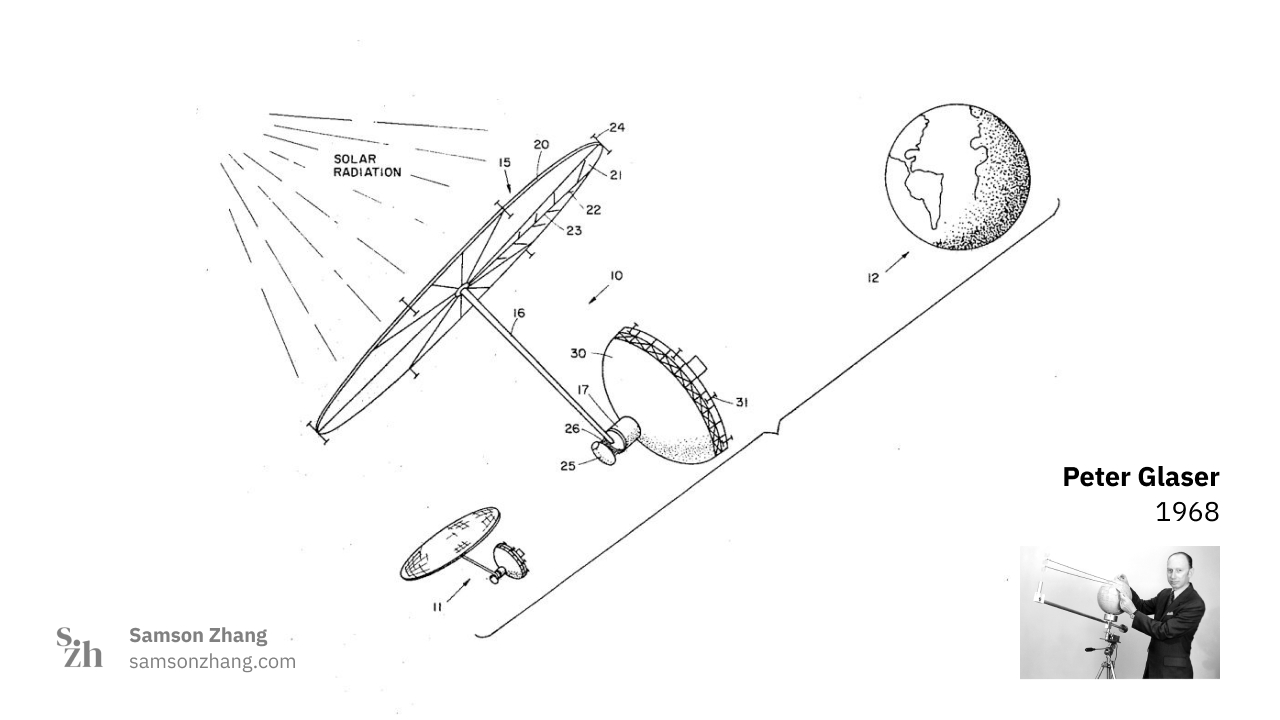
Why do this? A quick look at the numbers reveals that space solar power actually offers huge advantages over terrestrial solar power.
For starters, solar energy is 10x more intense in space than on the ground (1400 W/m^2 vs. 140 W/m^2), as it is not scattered and attenuated when traveling through the atmosphere. Per area, the energy that can be generated from sunlight is thus 10x greater.
Furthermore, terrestrial solar solutions can only generate power when exposed to sunlight. Considering day/night cycles and weather, the availability of sunlight is only 15% of constant exposure. A satellite in geosynchronous orbit, on the other hand, can be positioned in such a way as to receive sunlight 90% of the time.
End-to-end energy loss during transmission from space to ground is estimated at 50%. Overall, then, space solar power represents a 30x increase in the amount of energy generated per area compared to terrestrial solar power. Furthermore, this energy is constant, not dependent on day/night cycles or weather.

From space, power doesn't need to be beamed to a fixed location, either: power can be supplied to receiver stations all over the world. Imagine a future where a constellation of satellites provides energy to any point on earth, wherever a receiving station can be set up.
Space solar power offers an exciting vision for a reliable, powerful, and versatile source of renewable energy production. Let's dive into the history and details of the concept.
A Brief History of Space Solar Power
Preceding the development of the SSP concept was the development of wireless power transmission technology. Though Nikola Tesla's 1901 Wardenclyffe Tower may be the first thing that comes to mind, the history of wireless power transmission really begins in 1963, with Raytheon engineer William C. Brown developing the first microwave power transmitting and receiving systems.
In a 1964 demonstration, Brown kept a model helicopter afloat for ten hours, powered only by a microwave beam. From 1969-1975, he served as the director of a JPL-Raytheon program that culminated in two experimental results still unsurpassed today: transmission of power over a short distance with an end-to-end efficiency of 54%, and transmission of 320 kW of power over a distance of one mile using a deep-space antenna in Goldstone, CA.

Peter Glaser was a friend of Brown's, and as mentioned earlier first proposed the SSP concept in 1968.
In 1976, NASA and the U.S. Department of Energy conducted the first serious study on the concept. The concept was technically feasible, they determined, creating reference designs for a constellation of 60 multi-kilometer scale satellites delivering power to the earth.

Given a $900B (adjusted for inflation) price-to-first-kWh estimate from the reference design, the U.S. National Research Council and Congressional Office of Technology Assessment decided against the further pursuit of the SSP concept.
Near the turn of the century, advancements in power beaming and satellite technology prompted another set of studies. In 1994, Japanese researchers published a concept called SPS 2000, a demonstration mission for a megawatt-scale satellite to be launched into LEO. In 1997, NASA conducted the Fresh Look study, selecting designs such as the "Sun Tower" with drastically reduced costs. In 2001, the European Space Agency published the "Sail Tower" concept, improving upon NASA's "Sun Tower".
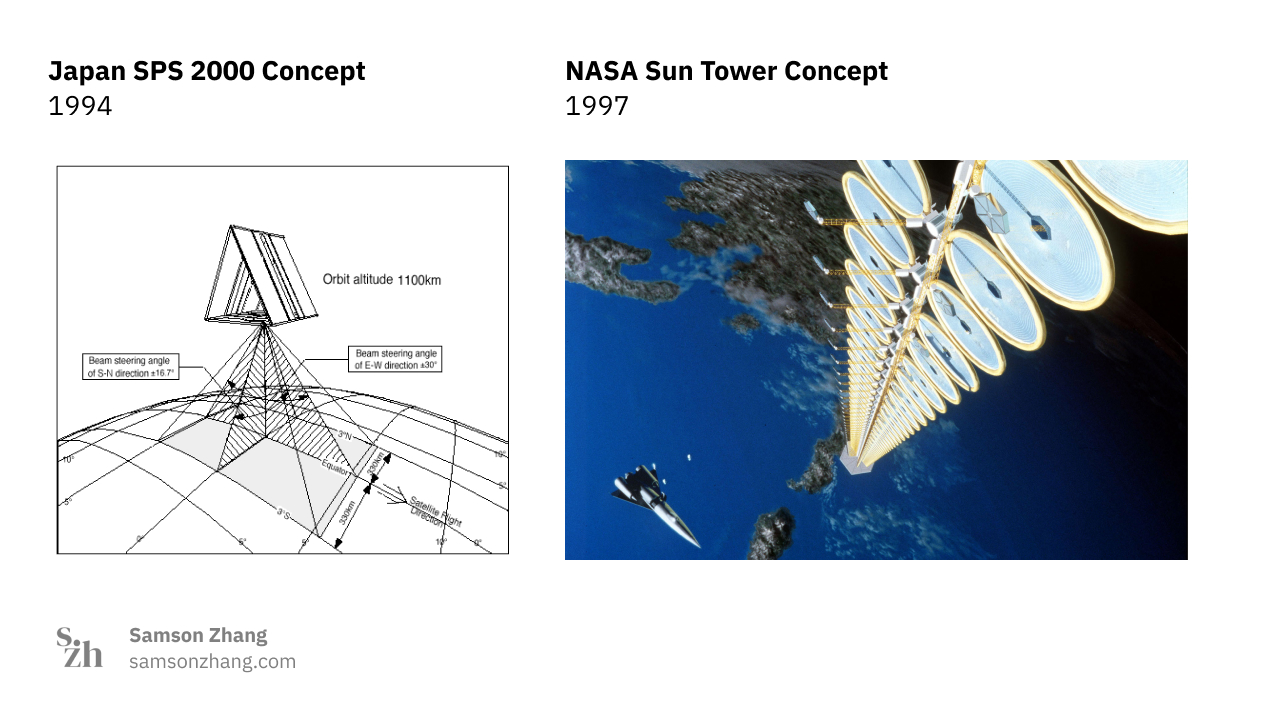
In the meantime, wireless power transmission research continued to be conducted, with non-SSP applications tested such as powering drones and blimps.
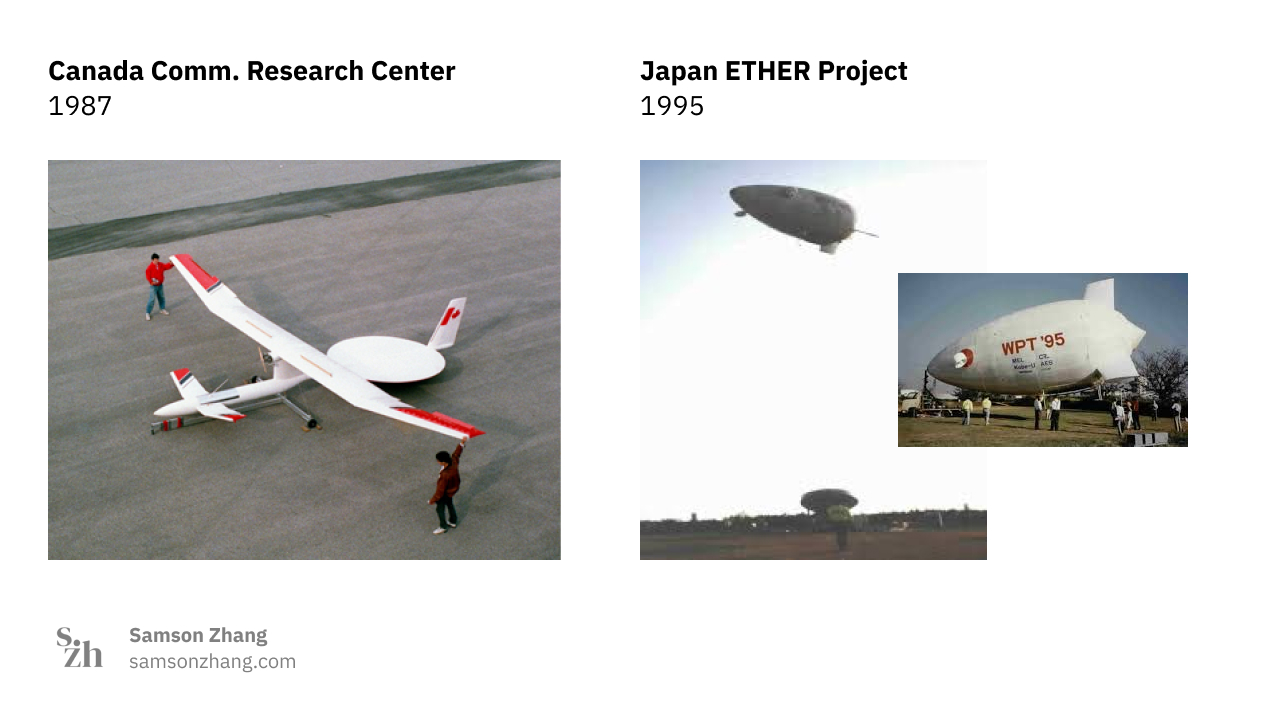
Since then, there have been a huge variety of SSP concept proposals, with designs ranging from complex reflector systems to integrated sandwich panels, and revisiting older designs like the 1979 reference.
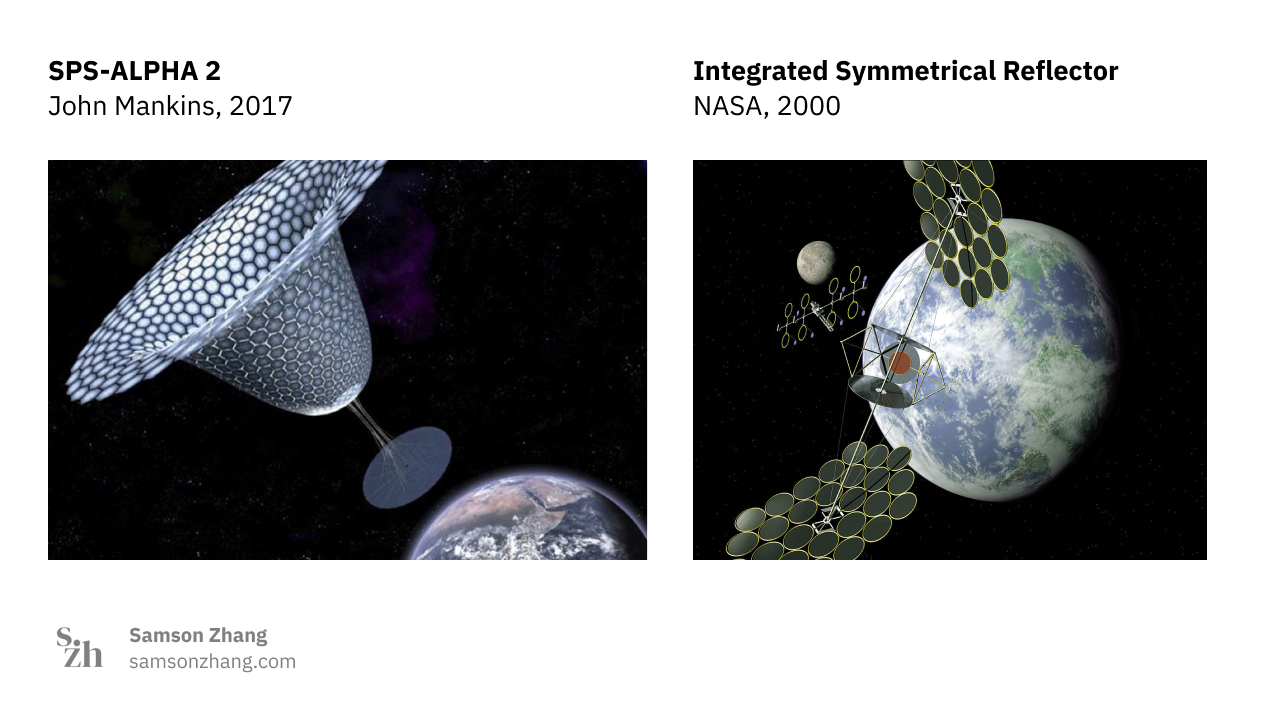
Yet, for all the research and interest in the SSP concept, there are no satellites in orbit beaming down electricity right now. Why is that? What are the challenges and limitations of this solution?
Challenges and Limitations of Space Solar Power
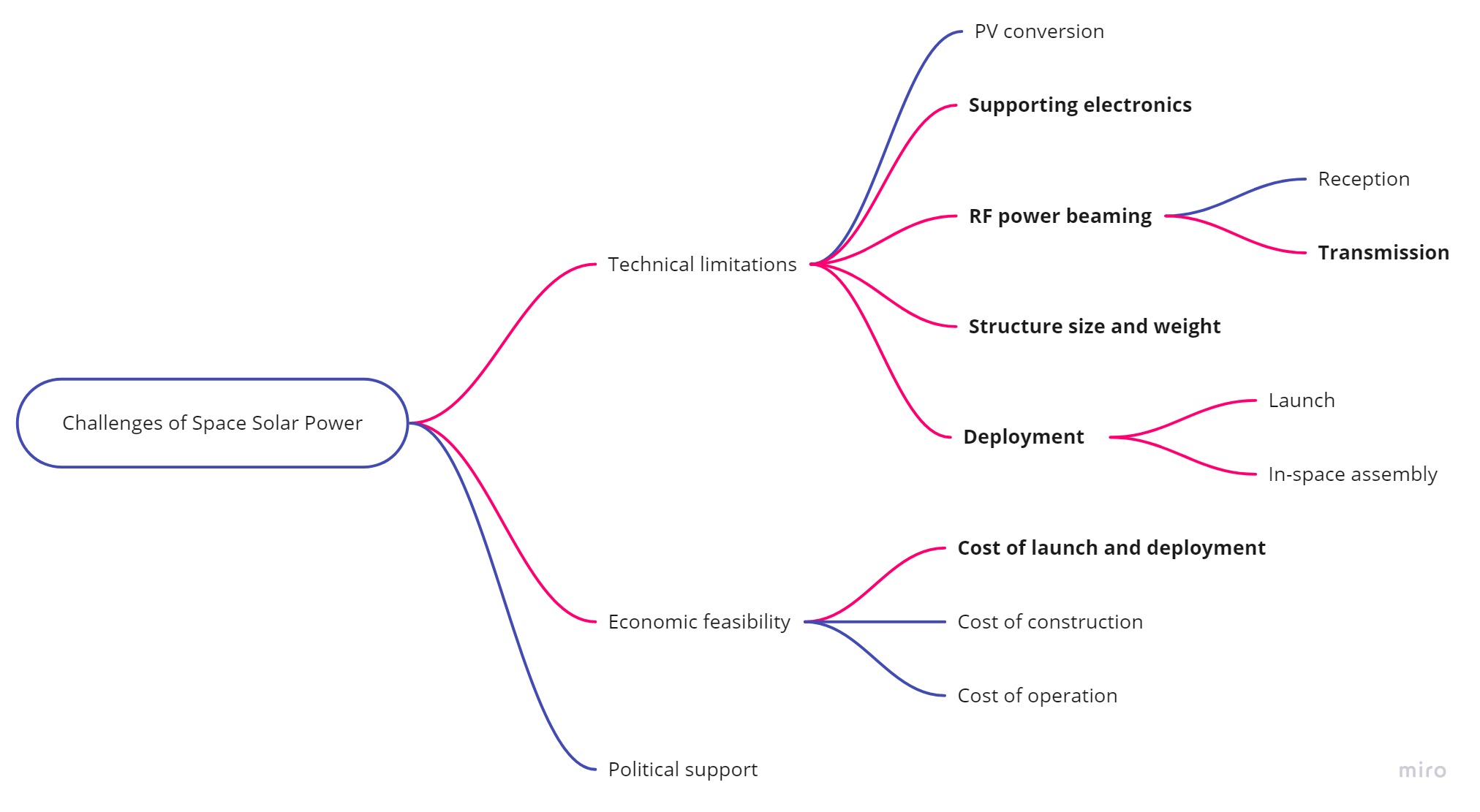
Power Beaming Technology
General Principles
The piece of space solar power that immediately seems the most foreign is the beaming of electricity from orbit down to the surface of the Earth.
As mentioned previously, much research has already been done on power beaming. Here's the general principle: electricity is simply voltage and current across a load. In direct current, the voltage and current maintain their direction; in alternating current, the voltage and current oscillate sinousoidally. In the U.S., wall power delivers an alternating current oscillating at 60 Hz.
Instead of electrons through a conductor, these oscillations can be carried by photons through vacuum or another medium, i.e. electromagnetic waves, then converted back into oscillating voltage and current by a receiving antenna.
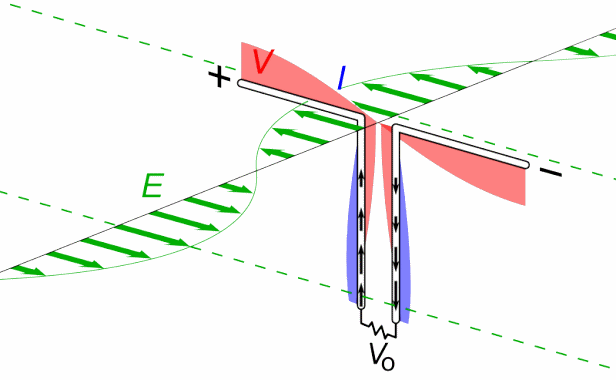
Image source: https://commons.wikimedia.org/wiki/File:Dipole_receiving_antenna_animation_4_616x380x150ms.gif
There's a wide spectrum of possible electromagnetic wave frequencies. From 4e14 to 8e14 Hz frequency, or 380nm to 740nm wavelength, is visible light. The higher the frequency, the more energy is carried; this is why gamma rays, x-rays, and ultraviolet light are potentially harmful to be exposed to.
Not all frequencies of EM radiation are able to penetrate Earth's atmosphere, however. Frequencies above visible light are blocked, as is infrared light and long-wavelength radio waves. Visible light is distorted, and blocked by weather, i.e. cloud cover.

Image source: http://gsp.humboldt.edu/OLM/Courses/GSP_216_Online/lesson2-1/atmosphere.html
That leaves radio waves as the frequency range where EM radiation can travel down from space and through the atmosphere. It's why communications satellites and broadcast towers use radio frequencies for their transmissions.
Microwave Transmission
For maximum power transmission, we want the highest frequency that can reliably penetrate the atmosphere. This happens to be microwave, between between 1 and 10 GHz (30 to 3 cm wavelength).
That's right, the same kind of microwave emitted by your microwave oven. In fact, the core piece of technology used in many wireless power transmission technology experiments is the same as what powers microwave ovens: the magnetron.
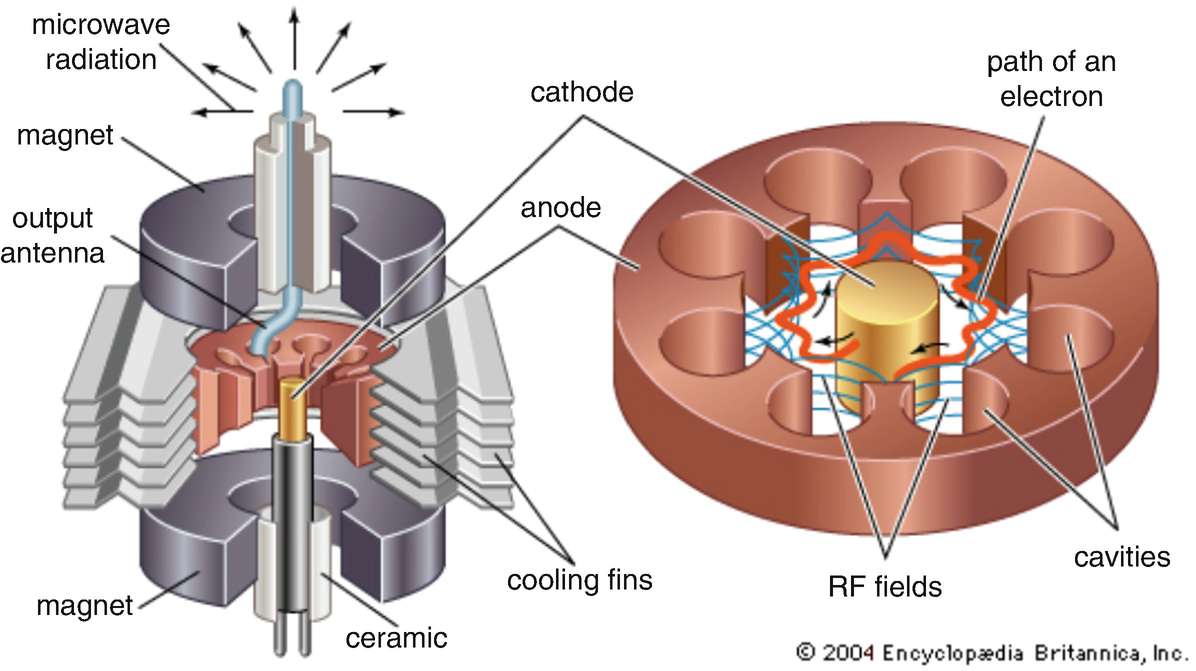
Image source: Encyclopedia Britannica
The magnetron is a type of electron tube that outputs RF radiation at a desired frequency, determined by the shape of resonant cativites that electrons are driven through. They have theoretically high efficiencies, and magnetrons with a power output of 500-1000W are cheaply mass produced. Brown used magnetrons -- much further developed for the tightly controlled phase and frequency necessary for power transmission -- for his 1964 model helicopter demo and 1975 54% end-to-end efficiency record.
Other kinds of electron tubes were used for other wireless power transmission experiments: klystron tubes have a higher power output, and were used for Brown's 1975 1 mile power transmission experiment, for example.
While magnetrons and klystrons are candidates for large-scale SSP applications, they're very heavy and pose challenges for launching and deploying SSP systems. More recent research has been devoted to the development of solid-state semiconductor-based microwave amplifiers, using transistors made of gallium arsenide (GaAs), gallium nitride (GaN) and silicon carbide (SiC). While solid-state amplifiers have yet to reach the high power output or low cost of tube-based amplifiers, they are much smaller, making them more suitable for SSP applications.
Phased Array Beam Steering
The small size of solid-state amplifiers has another important benefit: their ability to be used in phased arrays. A phased array is an array of antenna elements that output RF waves at different phases such that their interference determines the direction that the beam travels in.
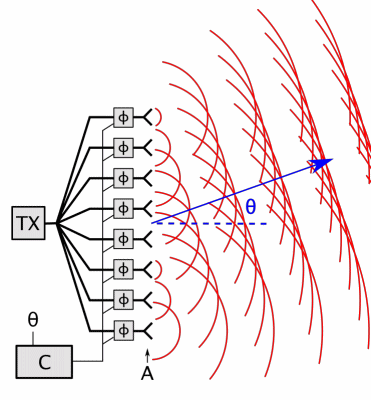
Image source: https://en.wikipedia.org/wiki/File:Phased_array_animation_with_arrow_10frames_371x400px_100ms.gif
Precise control of the direction of a microwave beam is crucial for SSP power beaming in order for the power to be received on the ground thousands of kilometers below. Phased arrays allow this beam steering to be controlled electronically, allowing for much higher precision and quicker adjustments than with mechanical beam steering. Phased arrays constructed from both magnetron and semiconductor amplifiers have been used for a variety of wireless power transmission experiments in the past, and continue to be developed for space solar power applications.
Limitations of Power Beaming Technology
For all the research and experimentation that has been done with power beaming, the scale of power beaming required for space solar power has never been demonstrated before. In fact, we are several orders of magnitude away from the power output and distance required for both demonstration and large-scale SSP designs.
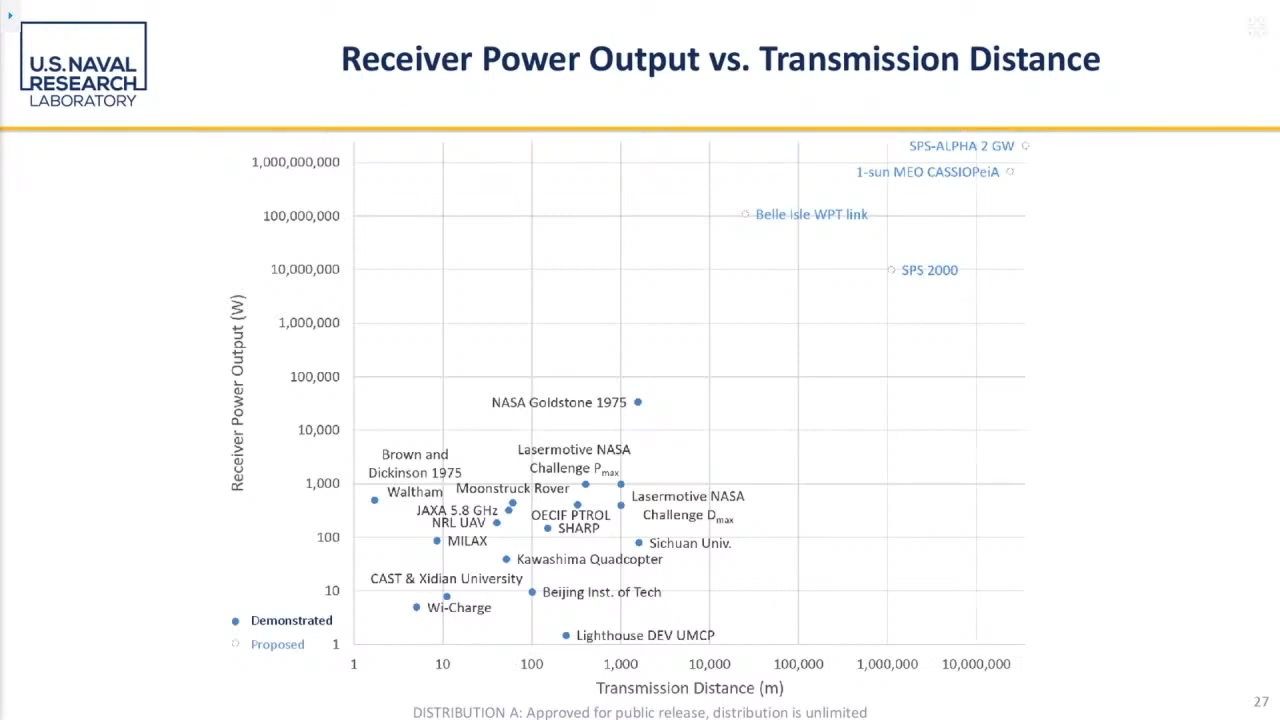
Image source: NRL/Dr. Paul Jaffe
Research on higher power and longer distance wireless power transmission systems continues to be conducted.
Structure Size and Weight
Another cause of challenges for the space solar power concept is scale of structures required: concept designs call for solar arrays and antennae with dimensions ranging from hundreds of meters to several kilometers in size.
One reason for the requirement of this large scale is simply to generate enough energy from the sun. Recall that the solar flux from orbit is arouznd 1400 W/m^2. Consider that the efficiency of advanced photovoltaic panels is around 25%, meaning a maximum of 350 W of power can be harvested per square meter of solar array.
On average, a single nuclear energy plant produces around 1 GW of power. To harvest 1 GW of power from the sun (not even accounting for the 50% transmission loss and other inefficiencies), 2.86 million square meters of photovoltaic surface would be required: that's a circular array two kilometers in diameter.
Another reason for the large size of SSP designs is a limitation of antenna physics. The efficiency of transmission is governed by the following set of equations:
$$ \tau = \pi \frac{D_t D_r}{4 \lambda R} $$
$$ \eta_b \approx 1 - e^{(-\tau^2)} $$
Where $$D_t$$ is the diameter of the transmitting antenna, $$D_r$$ is the diameter of the receiving antenna, $$\lambda$$ is the wavelength, and $$R$$ is the distance of transmission.
For, say, 90% efficiency of transmission at a wavelength of 3 cm (or 10 GHz frequency, the minimum wavelength that can reliably penetrate the atmosphere), over a distance of 36,000 km from GEO to the surface of the Earth, an antenna and rectenna of over 1.4 km in diameter each would be required. From MEO at 20,000 km, this number drops down to around 1 km, and even from LEO at 1,000 km, this number is 241 m.
In the 1970s when SSP was first proposed, this scale of structure was both imaginatively possible, and economically completely infeasible. Coming off of the rapid innovation of the space age, space technologists dreamed of space cities with hundreds of workers living on them, from which a massive structure like a space solar power station could be built. At the same time, using researcher Prof. Naoki Shinohara's estimate that a 1 GW scale SPS would weigh 10,000 tons, it would have cost more than $450B just to launch the mass of the structure into space on the Space Shuttle, 32 tons at a time (the Space Shuttle also didn't enter service until 1981).
Recent launch cost reductions, and projections for extremely low future launch costs such as those made by SpaceX for Starship, have brought the cost of launching such a massive structure into space within the realm of other renewable energy sources.
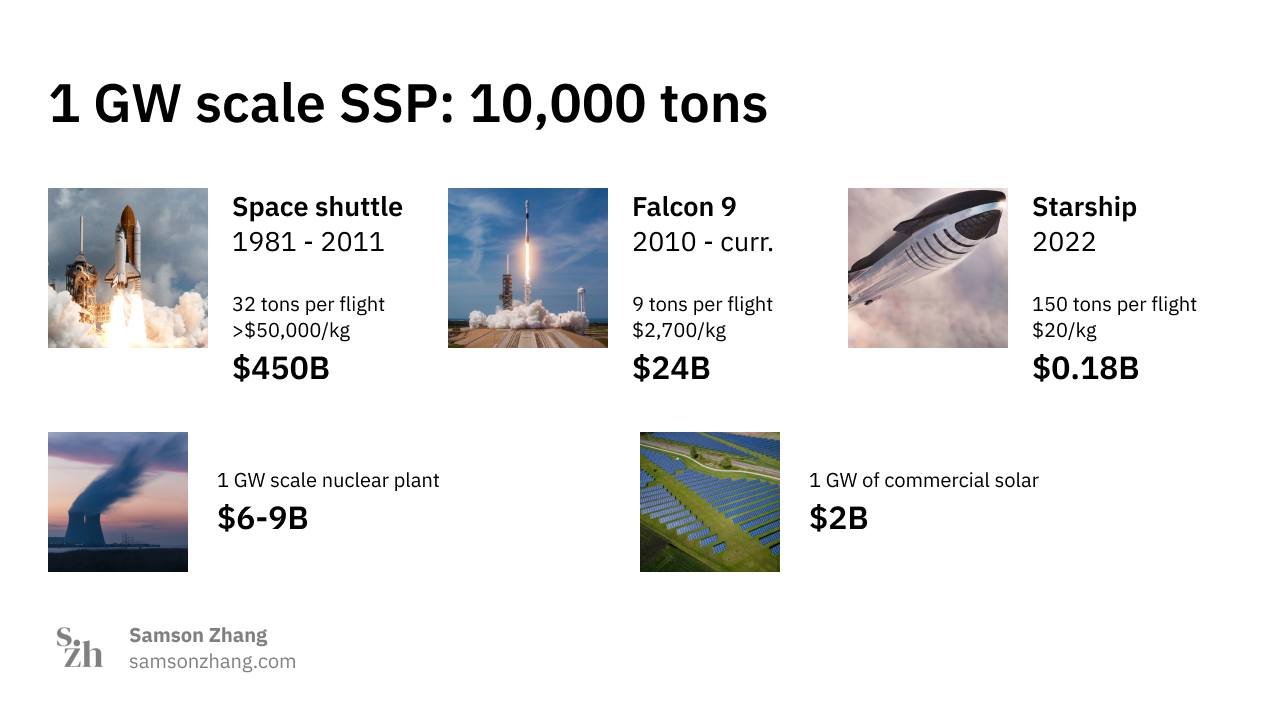
Concepts before the turn of the century acknowledged that big developments in Earth to orbit launch technology were needed, and many large-scale concepts today continue to do so. Another approach is to reduce the mass of the system drastically, or scale down the size and output for demonstration purposes. Caltech's Space Solar Power Project, for example, aims to develop a sandwich-style SPS with an areal density of 160 g / m^2. At this density, their initial 3 km by 3 km modular design would have a mass of only about 1,600 tons -- still requiring many launches, but a drastic reduction from the previous 10,000 ton estimate.
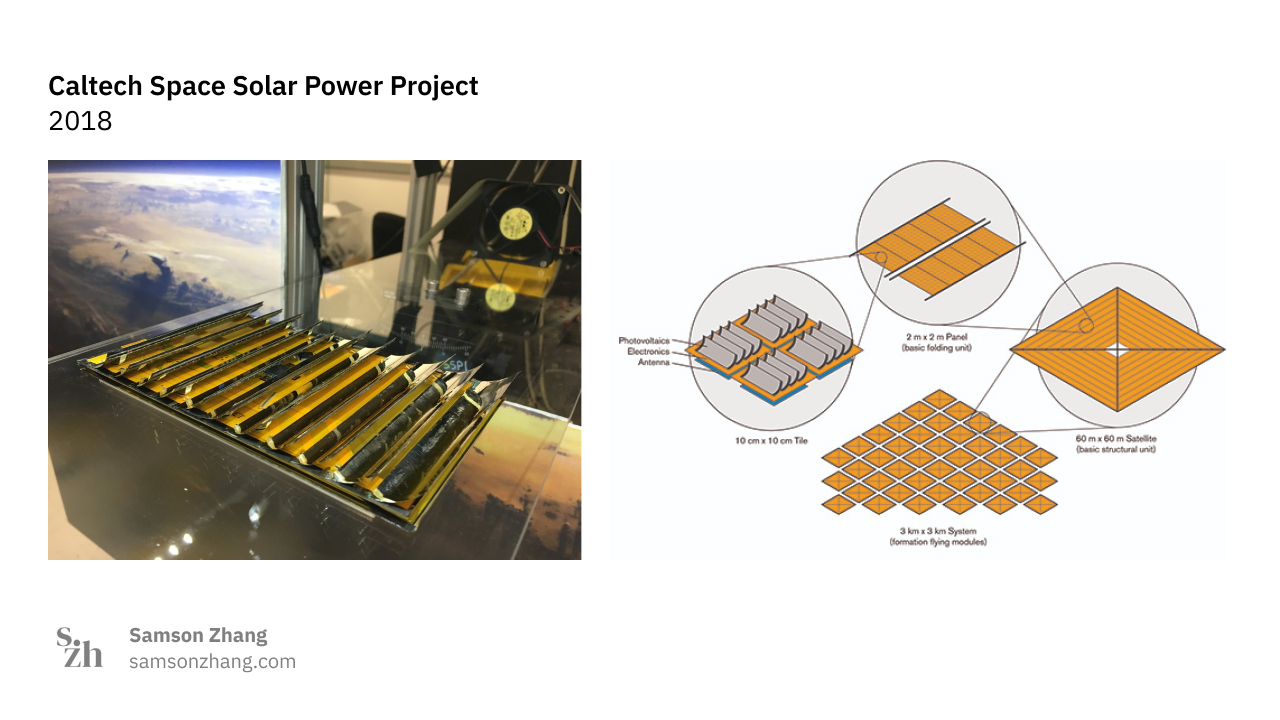
Deployment
Related to the massive size required for space solar power stations, the deployment of these structures in space poses another concern.
Early concepts pointed to in-space human and robotic construction of SSP structures. More recent concepts, such as John Mankin's 2012 SPS-ALPHA, propose a highly modular design and limited, automated in-space assembly via integrated robotic components. Other concepts, like the previously mentioned Caltech Space Solar Project, envision a system that can efficiently fold up for launch and automatically deploy in space, drawing inspiration from paper origami.
In-space construction is a topic of interest outside of SSP applications as well. In 2020, NASA awarded $142M to Maxar Technologies as part of its On-Orbit Servicing, Assembly, and Manufacturing (OSAM) initiative, developing a robotic spacecraft to service satellites in LEO. Later the same year, $73M was awarded to Made in Space's Archinaut One project, which will 3D print and deploy a solar array after arriving in orbit in 2022.
Other Limitations
Auxillary systems are needed to support SSP as well outside of the most visible challenges of power beaming technology and large space structure deployment.
Thermal management is a concern for any satellite, as all circuits generate excess heat, and vacuum doesn't provide any medium for heat to radiate away through. Solar panels and payload electronics both produce heat on a typical satellite. In a SPS, both many more solar panels will be required, and other electronics will be operating with much higher levels of power than the electronics on a typical satellite would operate at, exacerbating the need for effective thermal management of photovoltaics, electronics, and RF transmitters.
The efficient reception and conversion of power from RF to DC on the ground, and further distribution via connection to the local power grid, poses another set of engineering challenges.
Safety and regulatory concerns must also be met. Microwave power beams can be controlled to be harmless to objects or animals that pass through it: the power density of such a beam is less than a quarter of that of the sun at the same spot in the atmosphere. The use of radio frequencies is furthermore regulated by international governing bodies like the (asdfasdf), who in recent years have began drafting regulations for short-distance wireless power transmission, and will need to approve of standard wavelengths and licenses for long-distance power beaming before space solar power can become a reality.
The Future of Space Solar Power
Space solar power is a concept that has been around for several decades. There are many challenges in power beaming, launch and deployment, and supporting technologies to be overcome for space solar power to be a reality.
Yet, continuous innovation in space technology, the development of promising terrestrial and shorter-range wireless power transmission technologies, and the increasingly urgent need for renewable energy sources to mitigate climate change, have led to a resurgence of support for the pursuit of space solar power in the last decade.
Caltech's Space Solar Power Project received $17.5M in funding from Northrop Grumman in 2015, with three research groups developing photovoltaic, antenna, and deployment systems for an ultra-light modular sandwich design.
In 2001, the Japanese Ministry of Economy, Trade, and Industry laid out a roadmap to have an operational SSP system by 2040. Japanese researchers have made steady progress in the twenty years since, hitting miletsones of terrestrial point-to-point power transmission in 2015 and vertical transmission to a moving drone in 2018. METI's goals for the 2020s are to develop a combined light PV/RF light sandwich panel, and hit the new milestone of transmitting 1 kW of power over 1-5 km; then, in the 2030s, to launch demonstration satellites into space.
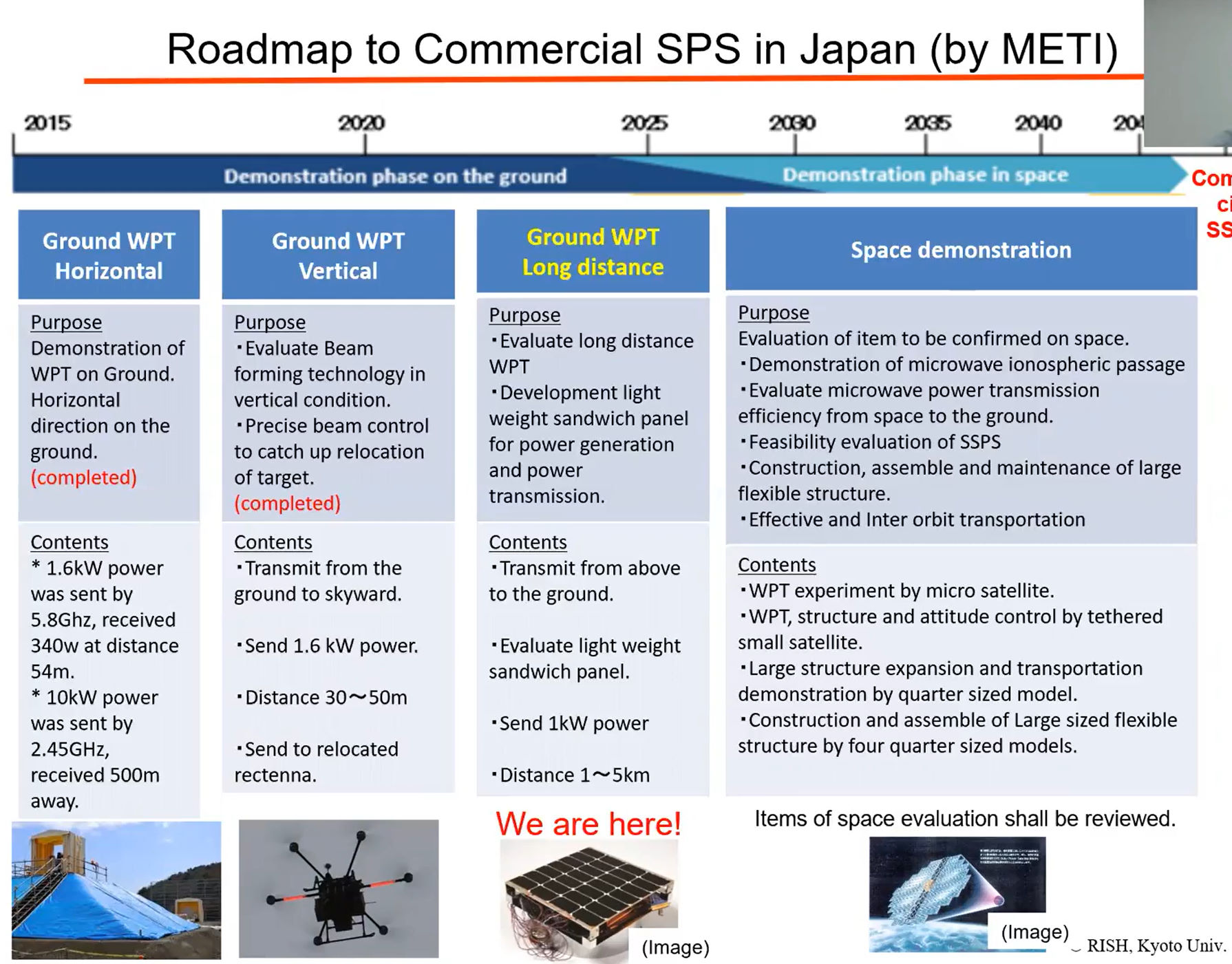
Image source: Prof. Naoki Shinohara
China similarly has technical roadmaps aiming to construct megawatt-scale SSP stations by 2030, and gigawatt-scale commercial stations by 2050.
The U.S. military has also been a supporter of wireless power transmission and space solar power research. Power beaming technology would extend the capabilities of unmanned drones, and be valuable for point-to-point power transfer in operating locations where securing energy would otherwise be difficult. The Naval Research Laboratory have been and are continuing to develop space solar power technology, such as a combined PV/RF panel in 2015. Most recently, the newly established Space Force also expressed interest in SSP development.
Considering these ambitious timelines, it's useful to remember a comparable example of technology development from history: GPS. GPS was first developed by the U.S. military in the 1960s for submarine navigation, a crazily ambitious idea put into execution within a decade of the first man-made object being launched into orbit. Following a 1983 aviation disaster, GPS was declassified and made available for civilian use; today, GPS and mobile cellular technology is ubiquitous.
Whether the vision of space solar power will develop like GPS technology and infrastructure remains to be seen, but it's a reminder that ambitious visions like these can be realized, and must be if we are to counter the humanity-threatening problem of climate change and dream of a future far bigger and better than our present.
Contact me
Have a question about my work? Want to work together? Don't hesitate to reach out!
Email me at hello@samsonzhang.com, or message me on Twitter @wwsalmon.